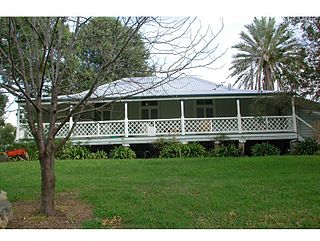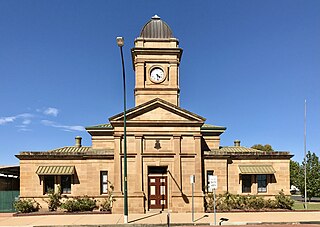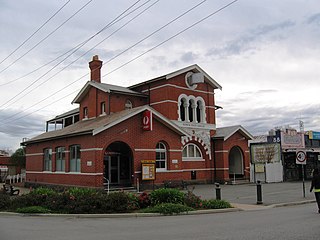
Maryborough Central State School is a heritage-listed state school at 471 Kent Street, Maryborough, Fraser Coast Region, Queensland, Australia. It was built from 1875 to 1953. It is also known as Central State School for Boys, Central State School for Girls, and Central State School for Infants. It was the first state school in Maryborough and was established with separate girls and boys departments. It is the oldest public school in Queensland. It was added to the Queensland Heritage Register on 31 October 1994.

Jondaryan Homestead is a heritage-listed homestead at Evanslea Road, Jondaryan, Toowoomba Region, Queensland, Australia. It was the base of the former Jondaryan pastoral station, which was originally taken up in 1840, and at one time was the largest freehold station in Queensland. The site contains the current house, which was built after the original was destroyed by fire in 1937, the original kitchen dating from 1844, and a kitchen, butcher's shop, shearer's quarters, stables, dairy, toilet block and store, many dating from the 1860s. It also contains the remains of horse stalls, a slaughterhouse, hide store, and Chinese gardener's glasshouse. It was added to the Queensland Heritage Register on 21 October 1992.

Lonsdale House is a heritage-listed detached house at 283 Boundary Street, Spring Hill, City of Brisbane, Queensland, Australia. It was built from 1860s circa to 1950s circa. It was added to the Queensland Heritage Register on 27 August 1999.

Warwick Court House and Police Complex is a heritage-listed courthouse at 88 Fitzroy Street, Warwick, Southern Downs Region, Queensland, Australia. It was designed by John James Clark and built from 1885 to 1914 by William G Conley. It was added to the Queensland Heritage Register on 21 October 1992.

Strathmore Homestead is a heritage-listed homestead at Strathmore Station on Strathmore Road, Springlands, Whitsunday Region, Queensland, Australia. It was built from the 1860s onward. It is also known as Strathmore Station. It was added to the Queensland Heritage Register on 13 November 2008.

Tumut Post Office is a heritage-listed post office at 82-84 Wynyard Street, Tumut, New South Wales, Australia. It was added to the Australian Commonwealth Heritage List on 22 August 2012.

Byron Bay Post Office is a heritage-listed post office at 61 Jonson Street, Byron Bay, New South Wales, Australia. It was added to the Australian Commonwealth Heritage List on 22 August 2012.

Cobar Post Office is a heritage-listed post office at 47 Linsley Street, Cobar, New South Wales, Australia. It was designed by James Barnet in 1885. It was added to the Australian Commonwealth Heritage List on 22 August 2012.

Narrabri Post Office is a heritage-listed post office at 138-140 Maitland Street, Narrabri, New South Wales, Australia. It is also known as Narrabri Post Office and former Telegraph Office. It was designed by the NSW Colonial Architect's Office under James Barnet and built by FA King in 1888. It was added to the Australian Commonwealth Heritage List on 08 November 2011.

Scone Post Office is a heritage-listed post office at 117 Liverpool Street, Scone, New South Wales, Australia. It was designed by the New South Wales Colonial Architect's office under the control of James Barnet and built in 1879. It was added to the Australian Commonwealth Heritage List on 22 August 2012.

Temora Post Office is a heritage-listed post office at 173 Hoskins Street, Temora, New South Wales, Australia. It was added to the Australian Commonwealth Heritage List on 8 November 2011.

Ayr Post Office is a heritage-listed post office at 155 Queen Street, Ayr, Shire of Burdekin, Queensland, Australia. It was designed by the Commonwealth Department of Interior and was built in 1936. It was added to the Australian Commonwealth Heritage List on 22 August 2012.

Bundaberg Post Office is a heritage-listed post office at 155a Bourbong Street, Bundaberg Central, Bundaberg, Bundaberg Region, Queensland, Australia. It was added to the Australian Commonwealth Heritage List on 8 November 2011.

Charters Towers Post Office is a heritage-listed post office at 17 Gill Street, Charters Towers City, Charters Towers, Charters Towers Region, Queensland, Australia. It was added to the Australian Commonwealth Heritage List on 8 November 2011.

Cooroy Post Office is a heritage-listed post office at 33 Maple Street, Cooroy, Shire of Noosa, Queensland, Australia. It was designed by Thomas Pye and built in 1914 by L. Baldry. It was added to the Australian Commonwealth Heritage List on 22 August 2012.

Maryborough Post Office is a heritage-listed post office at 227 Bazaar Street, Maryborough, Fraser Coast Region, Queensland, Australia. It was designed by Charles Tiffin and built in 1865–1866. It was added to the Australian Commonwealth Heritage List on 8 November 2011.

Ingham Post Office is a heritage-listed post office at 15 Lannercost Street, Ingham, Shire of Hinchinbrook, Queensland, Australia. It was built in 1935. It was added to the Australian Commonwealth Heritage List on 22 August 2012.

Euroa Post Office is a heritage-listed post office at 90 Binney Street, Euroa, Victoria, Australia. It was designed by John Thomas Kelleher of the state Public Works Department, possibly with the assistance of A. J. McDonald, and built in 1890 by George Diggle. It was added to the Australian Commonwealth Heritage List on 22 August 2012.

Sorrento Post Office is a heritage-listed post office at 10-16 Ocean Beach Road, Sorrento, Victoria, Australia. It was added to the Australian Commonwealth Heritage List on 22 June 2004.

Victoria Park Post Office is a heritage-listed post office at 414 Albany Highway, Victoria Park, Western Australia, Australia. It was added to the Australian Commonwealth Heritage List on 22 August 2012.





















